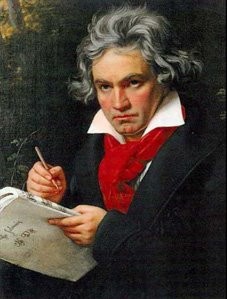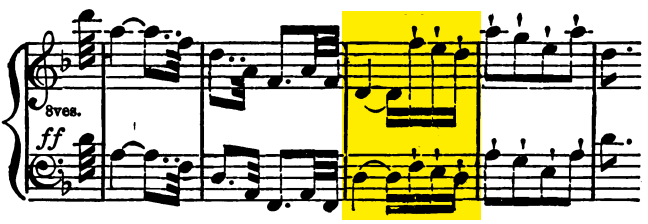
Beethoven, portrait by Joseph Karl Stieler (1820)
Beethoven completed his Ninth and last symphony, aka “Choral” symphony (in D minor Op. 125), in 1824, two years after he started it. The work is considered the first to incorporate human voice into the symphony form, with four soloists and a chorus to form its Finale, of which the text is mainly based on the poem “Ode to Joy” by Friedrich Schiller in 1785. The base melody has since gained universal popularity, to the extent that it was set to be the Anthem of Europe by EU in 1972.
In his essay on Beethoven’s nine symphonies, George Grove asserted that “it is still the opening Allegro that one thinks of when the Ninth Symphony is mentioned”[1]. While that may be the case 130 years ago when his essay was published, nowadays many people simply equate the Ode to Joy melody to the Ninth symphony! It would be totally inadequate and a grave mistake to associate the greatness of this monumental work only to that 16-bar tune, as popular perception often so does. To fully appreciate the depths and aesthetic beauty of the work one must listen to all movements of the work and appreciate it as a whole.
1. Allegro ma non troppo, un poco maestoso
The first movement is (rightfully) weighty and injects great array of emotions and dynamics to the whole work. The movement largely falls into conventional sonata form. It opens with a mysterious prologue on the strings:
It obviously forecasts the main subject which comes in with full force of the orchestra (the motif in highlight is used heavily in development in coda):

Exposition
In an unusual move Beethoven repeats the prologue again and comes back to the main subject (but now in a major mode), and take the last few notes of subject and elaborates further:
Soon the second subject is presented on woodwinds with a contrasting calmer mood:
We clearly hear the first portion of the subject predicting the Ode to Joy tune of the Finale, and the second portion is yet another new passage, which on its own may be considered to be the second subject.
From this point on the exposition moves on to great length in presenting a slew of new material that may not sound so obviously derived from the two earlier subjects. To me this is exactly the aspect of this great movement that is so moving and attractive. Grove described such “subsidiary themes…grow out of the principal one, as the branches, twigs, and leaves grow out of a tree”[2], and thus gives a sense of constant “restlessness” with forward moving momentum.
Just take a listen to a few ensuing subsidiary themes after the main subjects, like this sweeping downward phrase started by the strings:
and the forceful march-like rhythm that is heard more later on in the movement:
and the passage alternating first and second violins with growing intensity:
All those leading to the firm conclusion of the exposition emphasizing again the march rhythm:
The whole exposition (and the movement for that matter) grows non-stop in an organic way that reminds me of the first movement of Brahms Fourth, in which the main subjects too sound almost indistinguishable from other varying elements.
Development
The development section recalls the opening prologue again, and then lead to extensive development of the core motif of the main subject (see highlighted measure above):
soon after the main theme is developed into what Nicholas Cook referred to as a “mock fugato”[3]:
and near the end of development the main motif is called upon and pushed to a climax that leads directly to recapitulation:
Recapitulation
The recapitulation starts with the opening prologue but in such an entirely contrasting mood, with the full force of the orchestra, and most notably the tympani’s non-stop thundering for a full minute!
As always Beethoven puts a significant coda at the end of the movement, featuring again the core motifs of the main subject:
At last, similar to what Beethoven did in his previous Eighth symphony, the movement ends by quoting the opening prologue and the main motif:
Quoting Cook again on his assessment of the movement, “most striking is the sheet multiplicity of subsidiary materials”, the sonata form of the movement hides behind “a mass of thematic detail that is constantly renewed from moment to moment. And the repeated avoidance of strong cadences, together with a consistent tendency for harmonic resolutions to occur on weak beats, adds to the effect of continual motion”[4].
2. Molto vivace - Presto
Overall the Ninth Symphony has two large outset movements, and two relatively lighter (at least in mood, and certainly not necessarily simpler) movements sandwiched in the middle. While this is a typical structure of a four-movement symphony, what’s unusual here is Beethoven made the second movement a Scherzo rather than a typical slower movement.
In a similar way of the previous movement, the opening 8 bars call out the motif of the scherzo subject, which then starts promptly first on the violins, and then by the whole orchestra, energetic and buoyant:
A secondary subject follows, maintaining the rhythm but with a lighter color:
The Trio starts with a delightful melody on the oboe accompanied by the bassoon jumping around on arpeggios:
That accompaniment then become a contrasting theme on its own against the oboe; the development of the Trio is particularly charming, with the oboe, bassoon, French horn and the strings alternating on these two themes:
and then another new theme emerges from the lower strings:
The return of the scherzo is a full repeat, followed by a coda, making this Scherzo movement the longest of all Beethoven’s symphonies.
3. Adagio molto e cantabile - Andante moderato
Longer than the weighty opening movement, this slow movement comes with elegance and beauty, and unique form that is quite original and refreshing. The movement is basically a double variation on two distinctive and alternating subjects .
The first subject is in common time; its tempo of Adagio molto bringing us to a state of complete serenity and deep meditation. What’s unique is that the melody seems to present a “dialogue” between the Strings and Woodwinds; the phrases are first given by the Strings, followed by Woodwinds echoing and extending smoothly while carrying the melody forward. Here are roughly the 4 parts (phrases) of the first subject:
| Phrase 1: |
| Phrase 2: |
| Phrase 3: |
| Phrase 4: |
The second subject is completely different, changing the meter into 3/4 time, tempo faster now (Adante Moderato) and feels more relaxed; the melody is given by the strings in unison:
After the two subjects presented, the first variation comes in, with the Adagio doubles in rhythm with semiquaver form:
and the Adante is then repeated now by flute and other winds. The same semiquaver rhythm is repeated during the second variation, in which there are pieces of accompaniments by the horn with breathtaking breath and beauty, such as this:
Grove used words such as “beautiful dream” and “extreme beauty, dignity and elegance”[5] to describe this movement. One would never consider that being exaggerated after listening to this extraordinary music.
4. Allegro ma non troppo, un poco maestoso - Molto vivace - Adagio molto e cantabile
The last movement introduces the vocal component of this symphony with its famous Ode to Joy theme. Below is the theme’s score as it is first given by the cellos and basses:

The movement opens with what’s been often called a “horrified fanfare” in full force, disrupting in great shock the peaceful sense of the slow movement:
In his analysis, Cook presented an outline of the structure of the Finale movement, which can be considered as a large variation, mostly vocal, from the main Ode theme[6]:

Right after the fanfare is the famous passage of “review” of all themes from previous movements, where Beethoven dismisses all of them and welcomes the preview of the Ode theme on the winds when it is last presented:
Now the Ode to Joy theme is finally presented, very softly by cellos and basses, and then repeated three times, first by cellos violas, then violins, and lastly by full orchestra led by trumpet. There are amazingly beautiful accompanies by the bassoon in the first variation (“variation 1” in above structure table):
Vocal Section
With a shorter version of the opening fanfare repeated, the vocal portion is now started, first by the baritone soloist singing a recitative introduction:
The rest of key passages of variation are listed below, referencing the corresponding parts in the above structure table:
Variation 4 (more of a full statement than variation of the Ode theme in words by baritone):
Variation 5 by the four soloists:
Variation 6 by the soloists, ending with the full chorus:
Variation 7, “Turkish march”:
The exciting fugato episode based on Ode theme:
Variation 9, the most powerful and probably most quoted full chorus of Ode theme:
Episode “Seid umschlungen”. This is a contrasting motif yet still rooted in the Ode theme (it is then used in the ensuing double fugue):
Double fugue (based on Ode and Seid umschlungen themes):
The coda figure 1, by the soloists and joined by the chorus:
Coda figure 3, the powerful and triumphant climax of the Ode to Joy theme:
[1][2][5] Grove, George: Beethoven’s Nine Symphonies – Analytical Essays. Boston, 1888.
[3][4][6] Cook, Nicholas: Beethoven Symphony No. 9. Cambridge University Press, 1993.

